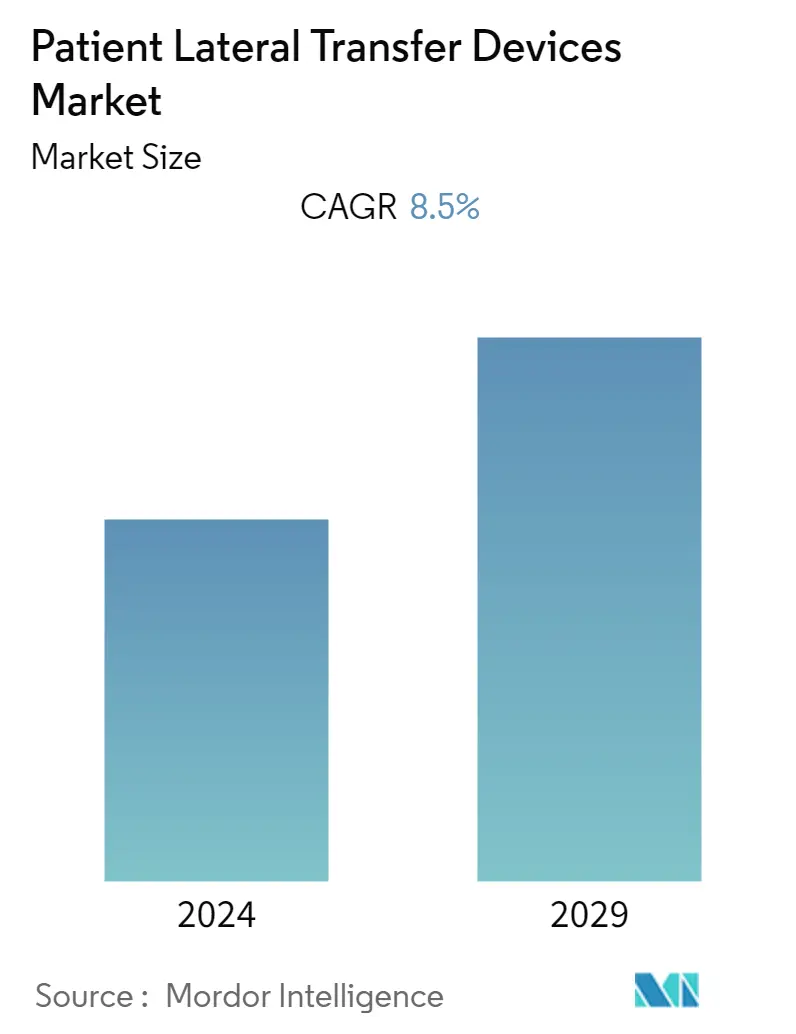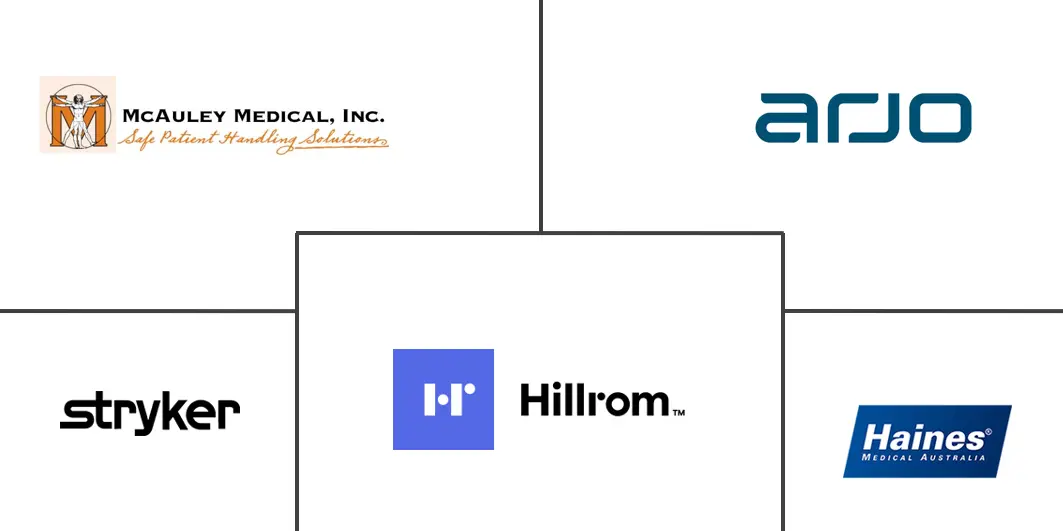Market Size of Patient Lateral Transfer Devices Industry

| Study Period | 2019 - 2029 |
| Base Year For Estimation | 2023 |
| CAGR | 8.50 % |
| Fastest Growing Market | Asia Pacific |
| Largest Market | North America |
| Market Concentration | Medium |
Major Players
*Disclaimer: Major Players sorted in no particular order |
Patient Lateral Transfer Devices Market Analysis
The patient lateral transfer devices market is expected to register a CAGR of 8.5% over the forecast period.
Due to the COVID-19 public health emergency, the demand for patient lateral transfer devices had slightly decreased due to the decrease in the number of surgical procedures. On the other hand, emerging complications with the SARS-CoV-2 virus have increased surgical complications post covid era, ultimately increasing the total number of surgeries performed within the countries. For instance, as per the article published in PubMed Central in December 2021, patients may develop severe pulmonary complications following the resolution of COVID-19, which can continue for months and influence the quality of life, I.C.U. hospitalization, or even death. Thus, the growing need for hospitalization will, in turn, propel patient lateral transfer devices across healthcare settings, thereby impelling market growth over the coming years.
The major factors contributing to the growth of the patient lateral transfer devices market are the increasing geriatric population and the rising burden of chronic diseases. According to the data from World Population Prospects 2022, the share of the global population aged 65 years or above is projected to rise from 10% in 2022 to 16% in 2050. By 2050, the number of persons aged 65 years or over worldwide is projected to be more than twice the number of children under age 5 and about the same as the number of children under age 12. Thus, the aging population is more prone to various chronic diseases which are expected to increase the demand for patient lateral transfer devices over the forecast period.
Therefore, the demographic trends pertaining to the aging population and the rising incidences of chronic diseases have led to the longer stay of patients in hospitals, which may increase the demand for patient lateral transfer devices over the forecast period, as they help transfer patients from their beds for any urgent medical purposes. According to the WHO data updated in July 2022, musculoskeletal diseases (MSD) are the main cause of disability globally, that affected 1.71 billion people globally in 2021. Thus, the burden of MSD globally is expected to drive demand for orthopedic splints, contributing to the overall market growth.
Moreover, the growing number of surgical procedures further leads to longer stays in hospitals, which is also a major factor driving the demand for patient lateral transfer devices. For instance, as per the American Health Association, in 2022, operating rooms resumed their activities and observed an upsurge in medical health treatments and surgeries, leading to only a 10% lower rate of surgery in comparison to the previous years.
However, the lack of a skilled workforce for handling the transfer of patients is one of the key factors hampering the growth of the market.
Patient Lateral Transfer Devices Industry Segmentation
As per the scope, patient lateral transfer devices are used for the transposition of a patient with minimal stress on the care provider. The diminishing level of friction in lateral transfers of patients aids in increasing the comfort of both patients and healthcare workers. The market report also covers the estimated market sizes and trends pertaining to 17 different countries across major regions, globally. The market is segmented by product type (air-assisted transfer mattresses, slide sheets, and lateral transfer accessories), usage (reusable and disposable), end user (hospitals, ambulatory surgical centers, and other end users), and geography (North America, Europe, Asia Pacific, and Rest of the World). The report offers values (in USD million) for the above segments. The market report also covers the estimated market sizes and trends pertaining to 17 different countries across major regions, globally.
| By Product Type | |
| Air-assisted Transfer Mattress | |
| Slide Sheets | |
| Lateral Transfer Accessories |
| By Usage | |
| Reusable | |
| Disposable |
| By End User | |
| Hospitals | |
| Ambulatory Surgical Centers | |
| Other End Users |
| By Geography | ||||||||
| ||||||||
| ||||||||
| ||||||||
| Rest of the World |
Patient Lateral Transfer Devices Market Size Summary
The patient lateral transfer devices market is poised for significant growth, driven by demographic shifts and increasing healthcare demands. The aging population and the rising prevalence of chronic diseases are key factors contributing to the market's expansion. As the global population aged 65 and above continues to rise, the demand for these devices is expected to increase, given their role in facilitating patient transfers in healthcare settings. Additionally, the burden of musculoskeletal diseases and the growing number of surgical procedures are further propelling the market, as these factors lead to longer hospital stays and a higher need for efficient patient handling solutions. The COVID-19 pandemic initially caused a dip in demand due to reduced surgical procedures, but the subsequent increase in surgical complications has led to a resurgence in the need for patient lateral transfer devices.
The market landscape is moderately competitive, with several global players such as Stryker Corporation, Arjohuntleigh, and Hill-Rom Holdings Inc. actively participating. These companies are focusing on innovation and strategic acquisitions to enhance their market presence. For instance, Arjo's acquisition of Airpal and Etac AB's acquisition of Hover Tech are examples of strategic moves to strengthen their positions in the market. The expanding healthcare infrastructure in emerging economies, coupled with government support, is also contributing to market growth. However, challenges such as the lack of a skilled workforce for patient handling remain a concern. Despite these challenges, the market is expected to witness robust growth, particularly in regions like North America, where the prevalence of obesity and chronic diseases is high, necessitating the use of patient lateral transfer devices.
Patient Lateral Transfer Devices Market Size - Table of Contents
-
1. MARKET DYNAMICS
-
1.1 Market Overview
-
1.2 Market Drivers
-
1.2.1 Rising Burden of Chronic Diseases and Increasing Hospital Stays
-
1.2.2 Increasing Adoption of Home Healthcare Services
-
-
1.3 Market Restraints
-
1.3.1 Lack of Trained Workforce for Patient Handling
-
-
1.4 Industry Attractiveness - Porter's Five Forces Analysis
-
1.4.1 Bargaining Power of Buyers/Consumers
-
1.4.2 Bargaining Power of Suppliers
-
1.4.3 Threat of New Entrants
-
1.4.4 Threat of Substitute Products
-
1.4.5 Intensity of Competitive Rivalry
-
-
-
2. MARKET SEGMENTATION
-
2.1 By Product Type
-
2.1.1 Air-assisted Transfer Mattress
-
2.1.2 Slide Sheets
-
2.1.3 Lateral Transfer Accessories
-
-
2.2 By Usage
-
2.2.1 Reusable
-
2.2.2 Disposable
-
-
2.3 By End User
-
2.3.1 Hospitals
-
2.3.2 Ambulatory Surgical Centers
-
2.3.3 Other End Users
-
-
2.4 By Geography
-
2.4.1 North America
-
2.4.1.1 United States
-
2.4.1.2 Canada
-
2.4.1.3 Mexico
-
-
2.4.2 Europe
-
2.4.2.1 Germany
-
2.4.2.2 United Kingdom
-
2.4.2.3 France
-
2.4.2.4 Italy
-
2.4.2.5 Spain
-
2.4.2.6 Rest of Europe
-
-
2.4.3 Asia Pacific
-
2.4.3.1 China
-
2.4.3.2 Japan
-
2.4.3.3 India
-
2.4.3.4 Australia
-
2.4.3.5 South Korea
-
2.4.3.6 Rest of Asia Pacific
-
-
2.4.4 Rest of the World
-
-
Patient Lateral Transfer Devices Market Size FAQs
What is the current Global Patient Lateral Transfer Devices Market size?
The Global Patient Lateral Transfer Devices Market is projected to register a CAGR of 8.5% during the forecast period (2024-2029)
Who are the key players in Global Patient Lateral Transfer Devices Market?
Stryker Corporation, Haines Medical Australia, ARJO, HILL-ROM HOLDINGS INC. and McAuley Medical Inc. are the major companies operating in the Global Patient Lateral Transfer Devices Market.

